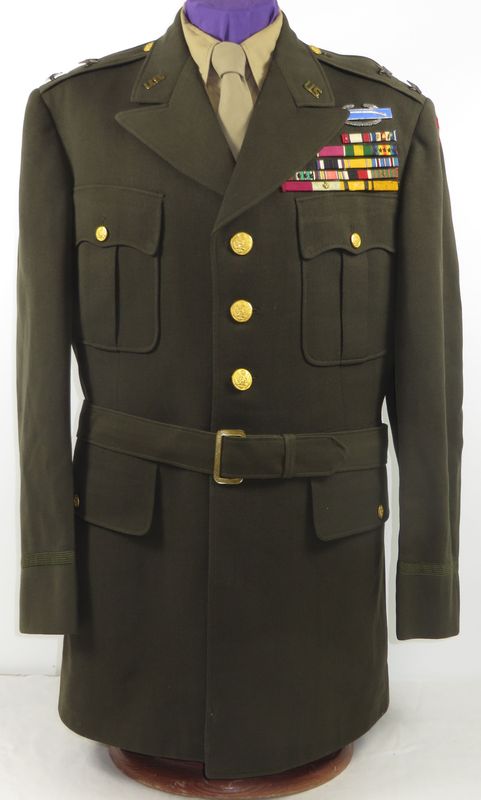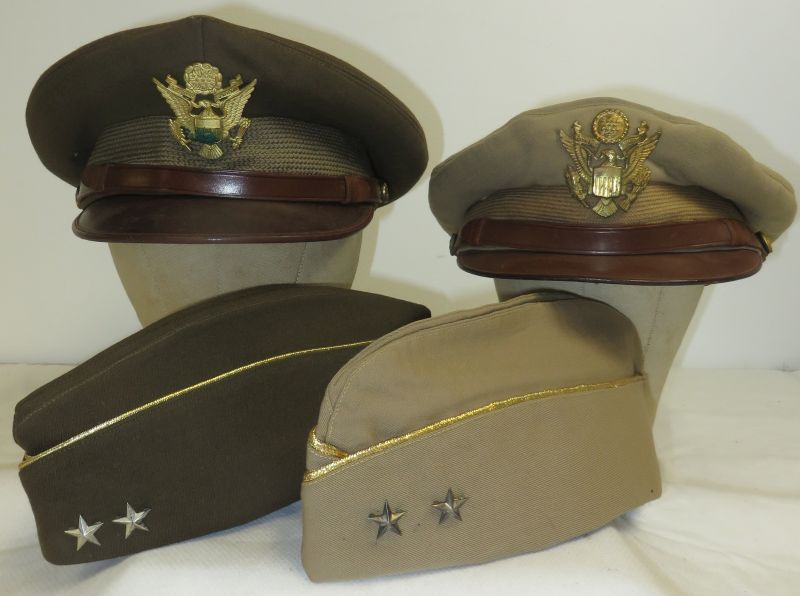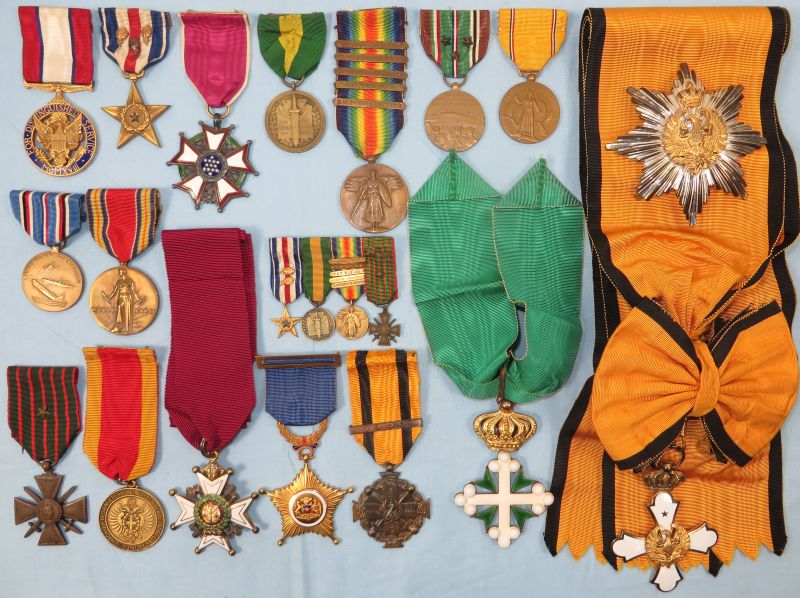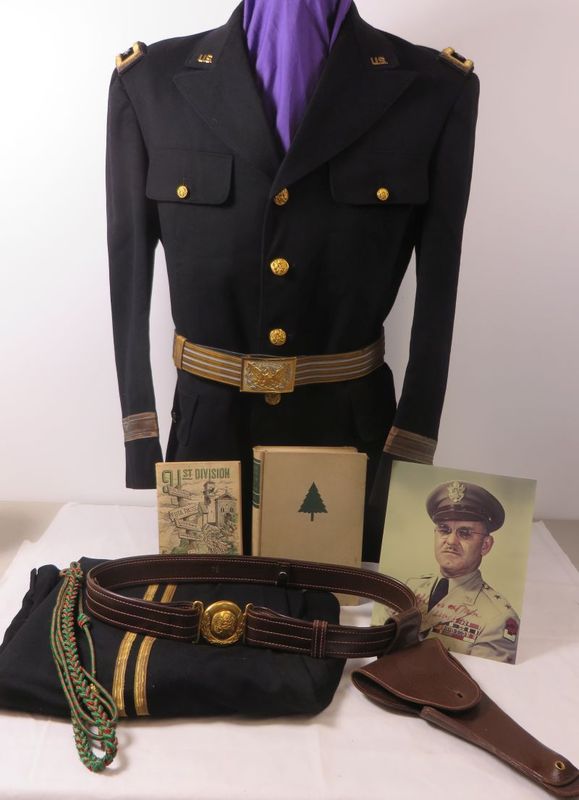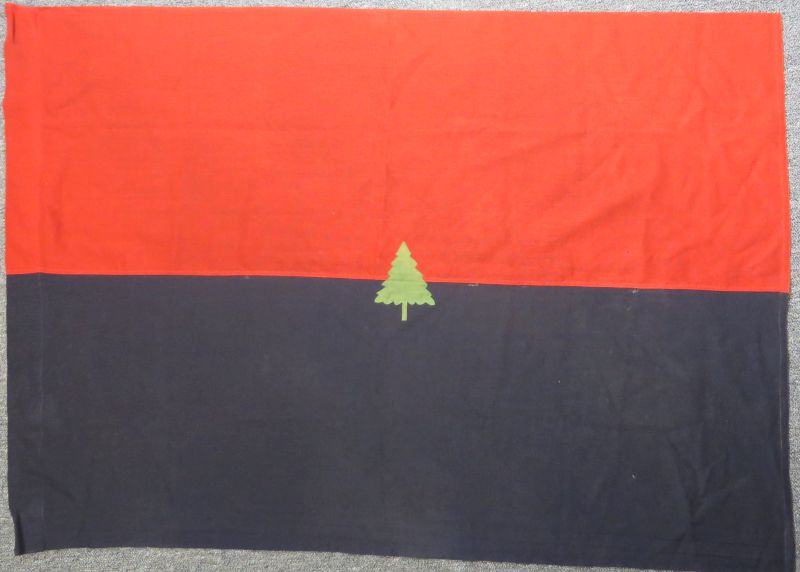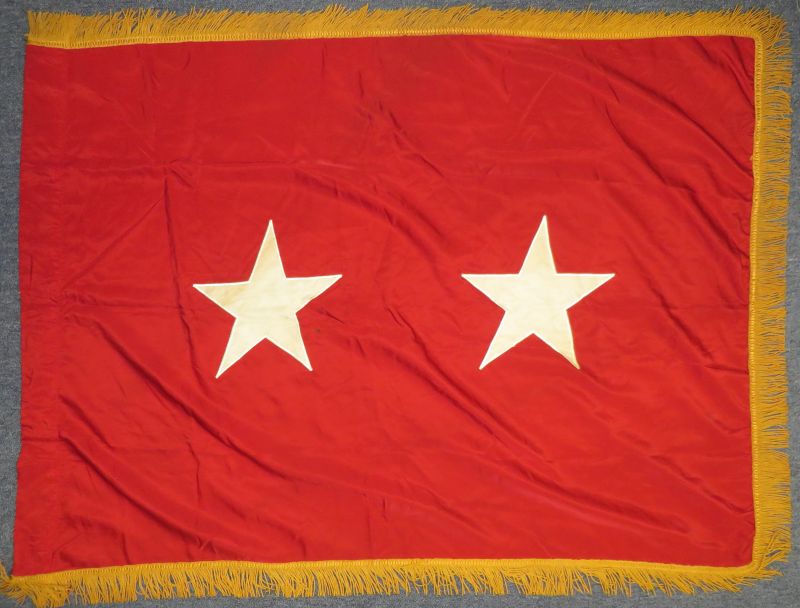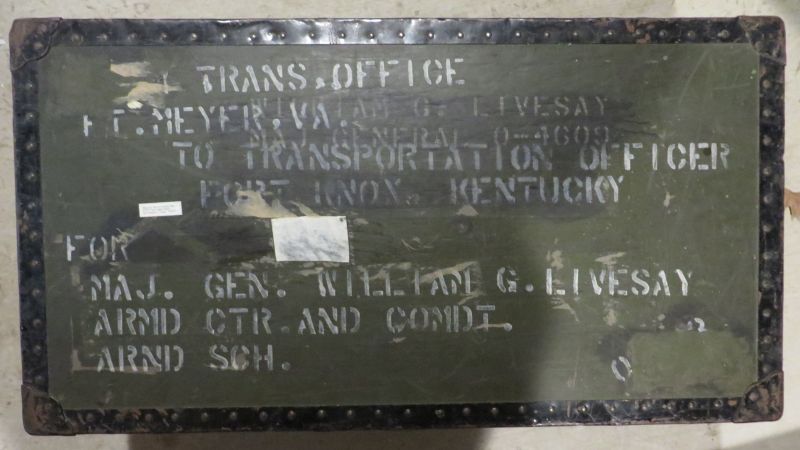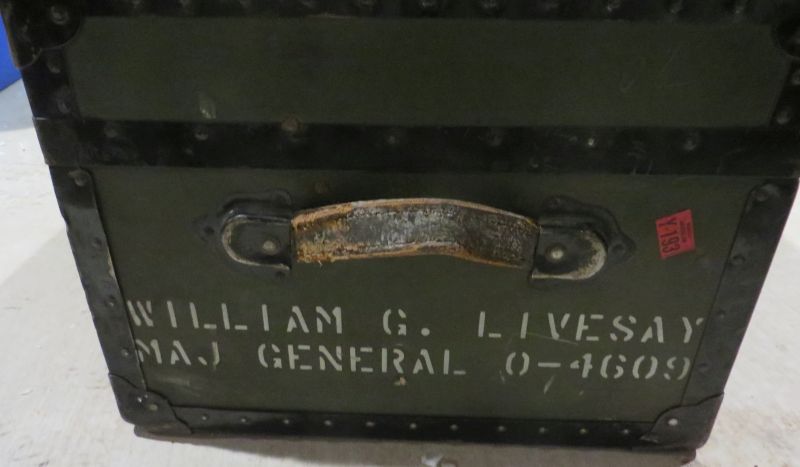Uniforms and Medals of Major General William Livesay
$16,500.00
An extensive and remarkably complete group of uniforms, medals, and memorabilia of a noted World War II combat General and Division Commander: Major General William Livesay.
BACKGROUND:
William Livesay began his military service as an enlisted man, joining the Regular Army on May 3 of 1915. In a career that would span more than three decades, General Livesay would serve with marked valor in combat in two world wars, command a U.S. Army division in some of the most ferocious fighting of the modern era, and assist a critical American ally in preserving its democratic government during the tumultuous Cold War. He would be recognized for his wartime courage and for his indomitable leadership with some of the most significant military medals and decorations that could be bestowed by the United States Army and by foreign governments.
After joining the army in 1915, Livesay served as an enlisted man with the 19th Infantry Regiment (the “Rock of Chickamauga”) on the Mexican Border. He rose to the rank of corporal, at which point his leadership abilities were clearly recognized and, despite the small size and the meager resources of the peacetime army, Livesay was selected for officer training. He was commissioned as a 2nd Lieutenant of Infantry in November of 1916 and he then attended the first officers class at Fort Leavenworth, Kansas, in early 1917. With the entry of the United States into World War I, Livesay was with the first contingent of American troops to arrive in France in June of 1917. He served as an infantry officer with the 28th Infantry Regiment of the 1st Infantry Division. For his valor in action he would receive three Silver Stars: for exceptional courage at Cantigny, France, in May of 1918; an oak leaf cluster for a second award of the Silver Star for valor at Exermont, France, on 5 October 1918; and a second oak leaf cluster, reflecting a remarkable third award of the Silver Star, for gallantry at Meuse-Argonne, on 11 October, 1918. He also was awarded the French Croix de Guerre with bronze star.
Following the war Livesay held a number of key assignments, including attendance at the Command and General Staff School in 1925; Instructor at the Army Infantry School in 1926; attendance at the Army War College in 1932; and service in the Office of the Chief of Infantry in 1936.
When the Second World War broke out, Livesay was serving as Chief of Staff of the Puerto Rican Department (for which he was awarded a Legion of Merit), when he was recalled to the continental United Sates and, after serving briefly as Assistant Divisional Commander of the 35th Division, he was made the Commanding General of the 91st Infantry Division. In that role he led the division to war in Europe and was one of the relatively few World War II Army Divisional Commanders to retain command of his division from its entry into combat until victory in Europe. The 91st Division would see some of the fiercest fighting of the war as it fought its way up the Italian peninsula, being awarded the North Apennines, Po Valley and Rome-Arno campaign streamers. For his valor in action, and for his aggressive leadership of this hard-fighting division, Livesay was awarded a fourth Silver Star (for gallantry in action at Vicenza, Italy on 28 April, 1945) and a Distinguished Service Medal, as well as being made a Commander of the Order of St. Lazarus of Italy and a Commander of the Order of the Bath of Great Britain.
Following the Second World War the liberated nations of Europe faced the very real danger of subversion of their new, democratic governments, by agents of communist insurrection. In June of 1947 Livesay arrived in Greece as Commander of the U.S. Army Advisory Group, with the mission to assist the democratic Greek government in defeating attempts that were being made to overthrow or subvert it. In this he was successful, and he was awarded the Medal of Military Merit of Greece and the Grand Cross of the Order of the Phoenix by the Greek government. General Livesay returned to the United States and in 1948 became the Commanding General at Fort Knox, following which he retired from military service.
This grouping of General Livesay’s material includes the following items:
UNIFORMS:
– General Livesay’s belted, four pocket olive green officer tunic, with two pin back stars on each shoulder; a 2nd Army patch on the left shoulder and a 91st Division patch on the right shoulder; a clutch back Combat Infantry Badge; and clutch back ribbon bars for the following medals and decorations: Distinguished Service Medal; Silver Star with 3 oak leaf clusters; Legion of Merit; Mexican Border Medal; World War I Victory Medal with 5 campaign stars; World War I Army of Occupation Medal; American Defense Medal; American Campaign Medal; European Campaign Medal with 3 campaign stars; World War II Victory Medal; World War II Army of Occupation Medal; French Croix de Guerre with bronze star; Order of the Bath of Great Britain; Order of St. Lazarus of Italy; Medal for Military Merit of Greece; and the Grand Cross of the Order of the Phoenix of Greece(the ribbon device reflecting Grand Cross status is missing). PLEASE NOTE that the shirt and tie pictured with this uniform jacket in the listing were NOT Livesay’s and are not included with the group; they were used only for purposes of display in the photograph.
– Dress Blue uniform, consisting of jacket and trousers, both named to Livesay on interior Washington, D.C., tailor labels, and dated December 6, 1948. The jacket shoulders each carry bullion and velvet shoulder straps of a Major General.
MEDALS AND DECORATONS:
– Distinguished Service Medal, slot brooch with swivel suspension, unnamed as awarded in the theater of operations;
– Silver Star decoration with 3 oak leaf clusters on the ribbon, the decoration being marked by Bailey, Banks & Biddle, split brooch, numbered 4439, and officially hand engraved “William G. Livesay”;
– Legion of Merit, early silver gilt example, unnamed as awarded, with a full wrap brooch numbered 14095;
– Mexican Border Service Medal, number 35695;
– World War I Victory Medal with clasps for Meuse Argonne, St. Mihiel, Aisne-Marne, Montdidier-Noyon, and Defensive Sector;
– World War I Army of Occupation Medal with slot brooch;
– American Defense Medal with slot brooch;
– American Campaign Medal with crimp brooch;
– European Campaign Medal with 3 stars on the ribbon, crimp brooch;
– World War II Victory Medal with crimp brooch;
– World War I French Croix de Guerre, dated 1914-1918, with bronze star on the ribbon;
– Order of St. Lazarus of Italy, Commander Cross, on full neck ribbon;
– Order of the Bath of Great Britain, Commander Cross, silver gilt on full neck ribbon;
– Medal of Military Merit of Greece, with “1940” bar;
– Cased Grand Cross of the Greek Order of the Phoenix, with sash, sash badge, and breast star, in the case of the Athens jeweler who created the decoration; and
– The “Decoration for Service in Gold” of the government of Chile, the reverse engraved “Major General William G. Livesay, U.S. Army”.
All of the decorations are in excellent condition, with the silver gilt awards showing a very dark, uncleaned patina.
There is also present in the group Livesay’s pre-World War II set of dress miniature medals, mounted on a pin back bar, comprised of the Silver Star with 2 oak leaf clusters (his third oak leaf cluster would be awarded for valor in Italy in 1945); the Mexican Border Service Medal; the World War I Victory Medal with the 5 bars that are on the full size medal; and the French Croix de Guerre with star.
HEADGEAR:
– Olive green wool visor cap by Luxenberg, size 7 1/4; the internal stitching of the sweatband has come loose at spots, and there is verdigris on the cap badge;
– Khaki color wool visor cap by Luxenberg, with General Livessay’s card beneath the sweat shield. The interior celluloid lining is darkened with age.
– Overseas cap, green wool, gold piping, with two sterling pin back stars;
– Overseas cap in khaki color wool, with gold piping and two pin back stars; the cap has a few small holes.
– Pre-WWII Army officer campaign hat, with gold and black officer cap cords, showing wear but with much character.
OTHER ITEMS:
Other memorabilia in the group includes the following items:
– World War II era flag of the 91st Infantry Division, a very scarce example of an official U.S. Army divisional flag with a Philadelphia Quartermaster label in the sleeve. The flag is 36 inches by 50 inches, multi piece wool construction, with a few small holes and one larger hole that is approximately 1/4 inch by 1/2 inch in size.
– General Livesay’s personal two star flag as a Major General. Philadelphia Quartermaster tag in the sleeve with the written notation “Gen. Livesay”. Artificial silk material as used in World War II, size 36 by 48 inches.
– World War II U.S. Army General’s brown leather pistol belt with the two piece gold buckle bearing the seal of the United States. The belt is overall about 40 inches long, though Livesay had adjusted it to a smaller size with the built-in snaps for size adjustment. There are two holsters: One holster is for the .45 caliber pistol, the other for a revolver. It is the .45 holster that is now on the belt, although the wear on the revolver holster makes it evident that, at one time, Livesay wore that holster on his pistol belt.
– Gold bullion and blue striped officer’s dress belt with large officer’s American eagle rectangular buckle.
– Book: The 91st Division, hardcover, first edition, 1947, by Major Robert Robbins. No dust jacket and the binding is loose. The front piece has a full page photo of General Livesay which was personally signed by him.
– Livesay’s World War I period dog tag, impressed “w.G. Livesay 2nd Lt. 30th Inf. USA” (the 30th infantry was his unit before going to France with the 28th infantry).
– A large gold metal membership card as Life Member number 1 in the 91st Division Association, engraved “Gen. Wm. Livesay.”
– Two signed 8×10 inch photographs, one black and white which shows Liveay with two other individuals, and a color 8 x 10 portrait photo that Livesay inscribed “To the officers and men of the 91st Division”, signed in red felt tip pen which has naturally faded somewhat.
– Livesay’s World War II period foot locker, stenciled with his name and rank. It was within this foot locker that General Livesay kept all of the items that make up this group.
A truly extraordinary group of uniforms, medals, decorations, and memorabilia of a noted American combat General of the Second World War.
Sold!

